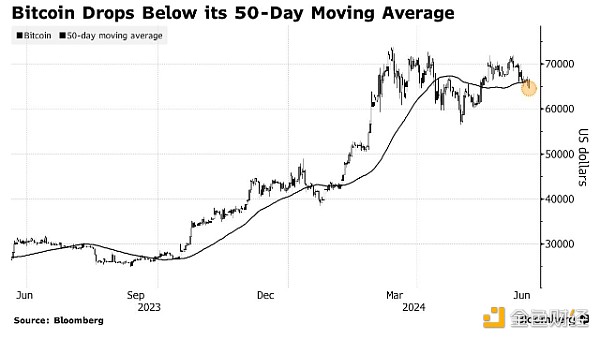Author: Sunil Jagtiani, Sidhartha Shukla, Bloomberg; Translated by: Deng Tong, Jinse Finance
Bitcoin hit its lowest in a month as outflows from digital asset investment products and the prospect of longer-term higher U.S. borrowing costs weakened cryptocurrency markets.
The largest digital asset fell as much as 2.7% on Tuesday, reaching levels not seen since mid-May, before paring losses to trade at $65,740 at 1:20 p.m. in Singapore. Smaller tokens such as Ethereum, Solana and Dogecoin also fell.

Withdrawals from digital asset products totaled about $600 million last week, the most since March, according to data from CoinShares International Ltd. Persistent inflation has led traders to scale back expectations for Federal Reserve rate cuts this year, posing a challenge for speculative investments such as cryptocurrencies.
Stocks and bonds have delivered higher returns than bitcoin this quarter, a reversal from the three months to March, when digital assets significantly outperformed traditional markets.
“Cryptocurrencies are increasingly vulnerable to macro triggers,” said Caroline Bowler, CEO of BTC Markets Pty, while adding that she remains optimistic in the long term.
Crypto market demand weakens
Cryptocurrency markets, including new coins, are showing signs of waning demand. The ZK token from a much-touted ethereum blockchain project dropped by a third after its debut on Monday, the latest in a string of much-anticipated tokens that have suffered a sharp sell-off.
In South Korea, a local report said new regulations coming next month could force exchanges to reduce the number of tokens available to investors. The country is an engine of demand for small-cap digital assets, so-called Altcoin, and the report may have spooked some traders.
Bitcoin prices have risen fourfold since the start of 2023 and hit an all-time high of $73,798 in March, helped by demand for dedicated U.S. exchange-traded funds. The rally has cooled recently as ETF inflows have slowed.





